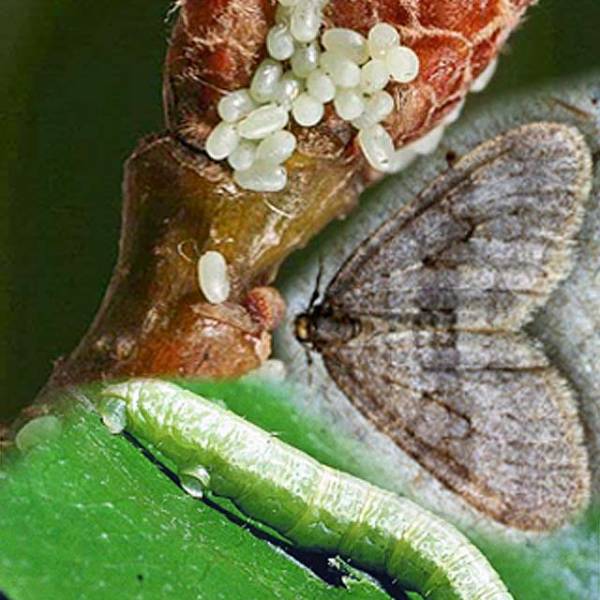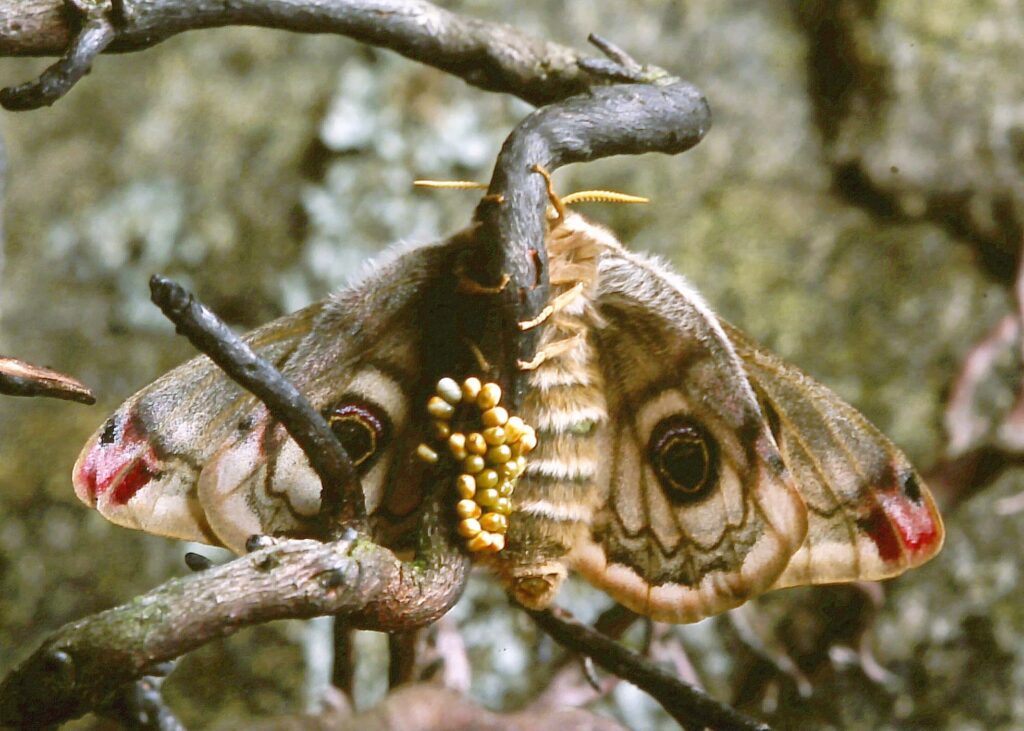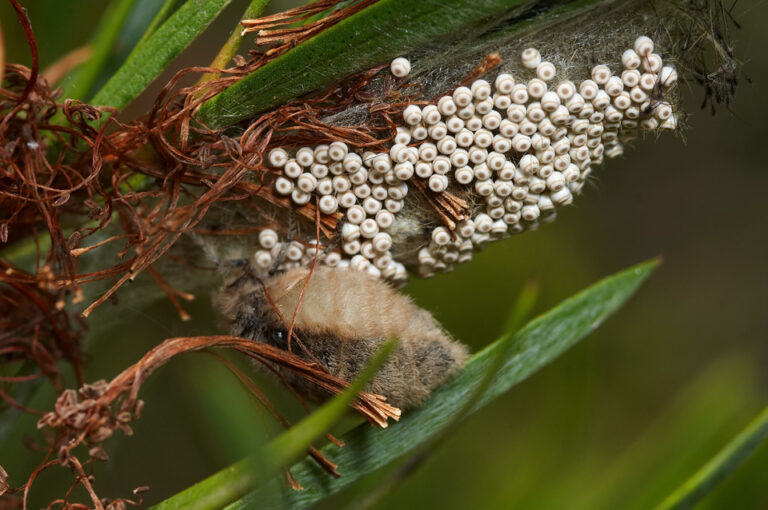Moth eggs typically hatch within one to two weeks, but the exact time varies depending on the moth species and environmental conditions. For example, silk moth eggs hatch in about 10-14 days, while clothes moth eggs take around 4-10 days.
Temperature and humidity play a significant role in determining hatching times. Warmer conditions tend to speed up hatching, while cooler temperatures may delay it.
How do species affect hatching times?
Moths belong to a diverse group of insects, and the hatching times of their eggs can vary significantly from species to species.
Different species have evolved to adapt to specific ecological niches and environments, leading to variations in their life cycles, including egg development and hatching.
Understanding these species-specific differences is crucial for researchers, entomologists, and conservationists studying moths and their ecological roles.
Environmental Conditions

Temperature: Temperature plays a crucial role in determining the rate of moth egg development and hatching. Warmer temperatures generally accelerate the hatching process, while cooler temperatures tend to slow it down.
Many moth species have evolved to synchronize their life cycles with seasonal temperature changes, ensuring that their eggs hatch at a time when food and environmental conditions are optimal for their larval development.
In laboratory settings, controlled temperature experiments can provide insights into the precise temperature thresholds for egg hatching in different moth species.
Humidity: Humidity levels also impact the hatching of moth eggs. Eggs need a certain level of moisture to remain viable and eventually hatch.
High humidity can prevent eggs from drying out and dying prematurely, which is especially important in arid environments.
Conversely, excessively high humidity can create conditions conducive to fungal growth, which can be detrimental to the eggs.
Moth species have adapted to various humidity levels, and some may have specific requirements to ensure the survival of their eggs.
Adaptations to Specific Environments
Moth species have evolved to thrive in a wide range of environments, from deserts to rainforests and from high altitudes to lowlands.
These adaptations often extend to their reproductive strategies, including egg development and hatching.
Moths that inhabit arid regions may have eggs that are highly resistant to desiccation (drying out), allowing them to survive in low-humidity conditions.
In contrast, species in humid environments may have eggs that can withstand fungal attacks or have mechanisms to cope with excess moisture.
Some moths have even developed specialized oviposition behaviors, such as selecting specific host plants or microhabitats, to optimize the survival of their eggs.
These adaptations reflect the intricate relationship between moth species and their native environments, highlighting the importance of considering local ecological factors when studying their hatching times.
What are silk moth hatching times?
These species have evolved specific timing adaptations to optimize their chances of survival and reproduction in their unique niches.
Silk Moths (e.g., Bombyx mori)
Silk moths, like the Bombyx mori, are known for their silk production and have been domesticated for thousands of years.
Their eggs typically hatch in about 10 to 14 days under optimal conditions. Furthermore, the hatching time can be influenced by temperature and humidity, with warmer conditions expediting the process.
In sericulture (silk farming), controlling the hatching time of silk moth eggs is crucial to manage the production of silk threads, as the larvae (silkworms) are harvested at specific developmental stages for silk extraction.
Butterflies (e.g., Monarch Butterflies):
Although butterflies belong to the Lepidoptera order, they share similarities with moths in their life cycle. Monarch butterfly eggs generally hatch in about 3 to 5 days.
Furthermore, the relatively short hatching time is an adaptation that helps the caterpillars quickly access their primary food source, milkweed leaves.
In addition, the rapid hatching also contributes to their survival as they are highly vulnerable to predators in their early stages.
Clothes Moths (e.g., Tineola bisselliella)
Clothing moths, such as Tineola bisselliella, are known for damaging textiles and fabrics.
Their eggs typically hatch in approximately 4 to 10 days.
The hatching time can vary depending on environmental conditions within homes, such as temperature, humidity, and the availability of suitable materials for larval development.
Moreover, controlling the hatching of clothes moth eggs is essential for preventing damage to clothing and textiles.
Luna Moths (e.g., Actias luna)
Luna moths are large, strikingly beautiful moths known for their pale green wings and feathery antennae. Their eggs generally hatch in about 7 to 10 days.
Luna moth caterpillars are voracious eaters and require a relatively short incubation period to access their primary food sources, typically leaves of various deciduous trees.
The hatching time ensures that the larvae can begin feeding during the optimal season for their host plants.
Hawk Moths (e.g., Manduca sexta)
Hawk moths, including species like Manduca sexta, are known for their strong, fast flight and long proboscis for feeding on nectar from flowers. Their eggs usually take around 5 to 10 days to hatch.
Hawk moth caterpillars have specialized adaptations for feeding on specific plants, and the hatching time is aligned with the availability of these host plants. In addition, these moths often have rapid development to make the most of the short window of opportunity for feeding and pupation.
How does temperature impact hatching times?

The average hatching time for moth eggs typically falls within the range of one to two weeks.
This time frame serves as a general guideline for moth egg development but can vary widely depending on several factors, including species, environmental conditions, and adaptations.
In addition, the one to two-week window represents a balance between the need for quick hatching to access food sources and environmental conditions that might influence egg survival.
Variability Within Species
It’s important to note that even within a single species of moth, there can be variability in egg-hatching times.
This variability can be attributed to genetic diversity within populations, regional adaptations, and microclimatic differences.
Factors like genetic diversity can lead to some individuals within a species having slightly shorter or longer hatching times than the average.
In some cases, such variability may confer advantages, allowing a population to better adapt to changing environmental conditions.
Influence of Temperature and Humidity
Temperature and humidity are key environmental factors that profoundly influence the hatching times of moth eggs.
- Temperature: Warmer temperatures generally expedite egg development and hatching. This is because higher temperatures accelerate metabolic processes, including the development of the embryo within the egg.
In addition, temperature also plays a role in determining the timing of hatching to synchronize with the availability of suitable food sources for the larval stage.
- Humidity: Adequate humidity is crucial for egg viability. Moth eggs need a certain level of moisture to remain viable and prevent desiccation.
While high humidity is essential in some cases to prevent eggs from drying out prematurely, excessively high humidity can create conditions conducive to fungal growth, which can be detrimental to the eggs.
Moth species have evolved to cope with specific humidity levels that are optimal for their eggs’ survival. Some may even have physical adaptations to retain moisture or prevent excessive water uptake.
FAQ’s
What kills moth eggs?
Moth eggs can be killed by various methods, including freezing, heating, and insecticides designed for moth control.
What temperature kills moth eggs?
Most moth eggs are vulnerable to temperatures below freezing (around 32°F or 0°C) and above certain high temperatures (typically above 120°F or 49°C), which can kill the eggs.
How fast do moth larvae hatch?
The hatching time for moth larvae can vary depending on the species and environmental conditions, but it generally ranges from a few days to a couple of weeks.
What kills moths permanently?
Permanently eliminating moths often involves a combination of measures, including thorough cleaning, sealing entry points, using moth repellents, and addressing any infested clothing or textiles. Ongoing prevention is also key.
Are moth eggs killed by washing?
Washing clothing or textiles can help remove moth eggs and larvae. Using hot water (above 120°F or 49°C) and drying items at a high temperature can effectively kill moth eggs.
What smells do moths hate?
Moths are often repelled by strong scents like cedar, lavender, cloves, and rosemary. These scents can be used as natural moth deterrents in closets and storage areas.
Can moth eggs spread?
Moth eggs themselves do not spread, but adult moths can lay eggs on different surfaces, potentially leading to infestations if conditions are suitable for the eggs to hatch and develop into larvae.
Can you see moth eggs?
Moth eggs are typically tiny and can be challenging to see with the naked eye. They are often laid in hidden, protected areas, such as folds in clothing or crevices in fabrics, making them difficult to detect without close inspection.
Final Words
In conclusion, understanding the hatching times of moth eggs is a nuanced endeavor, influenced by a combination of species-specific adaptations and environmental factors.
Moths, like many other creatures, have evolved intricate strategies to optimize the survival and development of their offspring. While a general timeframe of one to two weeks for moth egg hatching provides a useful guideline, there exists significant variability both within and between species.
Genetic diversity, regional adaptations, and the interplay between temperature and humidity all contribute to this variability.
Furthermore, the timing of egg hatching is often finely tuned to synchronize with the availability of suitable food sources for the emerging larvae.
As researchers, entomologists, and conservationists delve deeper into the world of moths, recognizing these complexities is crucial for understanding their roles in ecosystems and their responses to environmental changes.

